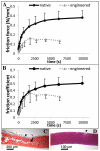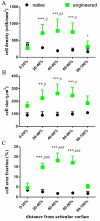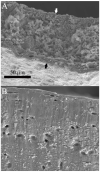Scaffold-free cartilage subjected to frictional shear stress demonstrates damage by cracking and surface peeling
- PMID: 24965503
- PMCID: PMC4641823
- DOI: 10.1002/term.1925
Scaffold-free cartilage subjected to frictional shear stress demonstrates damage by cracking and surface peeling
Abstract
Scaffold-free engineered cartilage is being explored as a treatment for osteoarthritis. In this study, frictional shear stress was applied to determine the friction and damage behaviour of scaffold-free engineered cartilage, and tissue composition was investigated as it related to damage. Scaffold-free engineered cartilage frictional shear stress was found to exhibit a time-varying response similar to that of native cartilage. However, damage occurred that was not seen in native cartilage, manifesting primarily as tearing through the central plane of the constructs. In engineered cartilage, cells occupied a significantly larger portion of the tissue in the central region where damage was most prominent (18 ± 3% of tissue was comprised of cells in the central region vs 5 ± 1% in the peripheral region; p < 0.0001). In native cartilage, cells comprised 1-4% of tissue for all regions. Average bulk cellularity of engineered cartilage was also greater (68 × 103 ± 4 × 103 vs 52 × 103 ± 22 × 103 cells/mg), although this difference was not significant. Bulk tissue comparisons showed significant differences between engineered and native cartilage in hydroxyproline content (8 ± 2 vs 45 ± 3 µg HYP/mg dry weight), solid content (12.5 ± 0.4% vs 17.9 ± 1.2%), shear modulus (0.06 ± 0.02 vs 0.15 ± 0.07 MPa) and aggregate modulus (0.12 ± 0.03 vs 0.32 ± 0.14 MPa), respectively. These data indicate that enhanced collagen content and more uniform extracellular matrix distribution are necessary to reduce damage susceptibility. Copyright © 2014 John Wiley & Sons, Ltd.
Keywords: damage; depth-dependent cellularity; frictional shear; mechanical properties; scaffold-free engineered cartilage composition; tribology.
Copyright © 2014 John Wiley & Sons, Ltd.
Figures








Similar articles
-
Surface zone articular chondrocytes modulate the bulk and surface mechanical properties of the tissue-engineered cartilage.Tissue Eng Part A. 2014 Dec;20(23-24):3332-41. doi: 10.1089/ten.TEA.2014.0099. Tissue Eng Part A. 2014. PMID: 24947008 Free PMC article.
-
Shear stress magnitude and duration modulates matrix composition and tensile mechanical properties in engineered cartilaginous tissue.Biotechnol Bioeng. 2009 Nov 1;104(4):809-20. doi: 10.1002/bit.22440. Biotechnol Bioeng. 2009. PMID: 19591192 Free PMC article.
-
[An in vitro study on three-dimensional cultivation with dynamic compressive stimulation for cartilage tissue engineering].Zhongguo Xiu Fu Chong Jian Wai Ke Za Zhi. 2014 Sep;28(9):1145-9. Zhongguo Xiu Fu Chong Jian Wai Ke Za Zhi. 2014. PMID: 25509782 Chinese.
-
Influence of the extracellular matrix on the frictional properties of tissue-engineered cartilage.Biochem Soc Trans. 2007 Aug;35(Pt 4):677-9. doi: 10.1042/BST0350677. Biochem Soc Trans. 2007. PMID: 17635119 Review.
-
Critical review on the physical and mechanical factors involved in tissue engineering of cartilage.Regen Med. 2015;10(5):665-79. doi: 10.2217/rme.15.31. Epub 2015 May 22. Regen Med. 2015. PMID: 26038952 Review.
Cited by
-
Apparatus and Method for Rapid Detection of Acoustic Anisotropy in Cartilage.J Med Biol Eng. 2020 Jun;40(3):419-427. doi: 10.1007/s40846-020-00518-7. Epub 2020 Mar 18. J Med Biol Eng. 2020. PMID: 32494235 Free PMC article.
-
A review of using green chemistry methods for biomaterials in tissue engineering.Int J Nanomedicine. 2018 Oct 4;13:5953-5969. doi: 10.2147/IJN.S163399. eCollection 2018. Int J Nanomedicine. 2018. PMID: 30323585 Free PMC article. Review.
-
Rapid Detection of Shear-Induced Damage in Tissue-Engineered Cartilage Using Ultrasound.Tissue Eng Part C Methods. 2018 Aug;24(8):443-456. doi: 10.1089/ten.TEC.2017.0513. Tissue Eng Part C Methods. 2018. PMID: 29999475 Free PMC article.
-
Review of the biomechanics and biotribology of osteochondral grafts used for surgical interventions in the knee.Proc Inst Mech Eng H. 2015 Dec;229(12):879-88. doi: 10.1177/0954411915615470. Proc Inst Mech Eng H. 2015. PMID: 26614801 Free PMC article. Review.
-
Nanomaterials in Drug Delivery: Strengths and Opportunities in Medicine.Molecules. 2024 May 31;29(11):2584. doi: 10.3390/molecules29112584. Molecules. 2024. PMID: 38893460 Free PMC article. Review.
References
-
- Anderson CE, Ludowieg J, Harper HA, et al. The composition of the organic component of human articular cartilage: relationship to age and degenerative joint disease. J Bone Joint Surg Am. 1964;46(6):1176. - PubMed
-
- Ateshian GA, Wang H. A theoretical solution for the frictionless rolling contact of cylindrical biphasic articular cartilage layers. J Biomech. 1995;28(11):1341–1355. - PubMed
-
- Ateshian GA. A theoretical formulation for boundary friction in articular cartilage. J Biomech Eng. 1997;119(1):81–86. - PubMed
-
- Basalo IM, Chahine NO, Kaplun M, et al. Chondroitin sulfate reduces the friction coefficient of articular cartilage. J Biomech. 2007;40(8):1847–1854. - PubMed
-
- Berson RE, Pieczynski WJ, Svihla CK, et al. Enhanced mixing and mass transfer in a recirculation loop results in high cell densities in a roller bottle reactor. Biotechnol Prog. 2002;18(1):72–77. - PubMed
Publication types
MeSH terms
Substances
Grants and funding
LinkOut - more resources
Full Text Sources
Other Literature Sources
Medical

